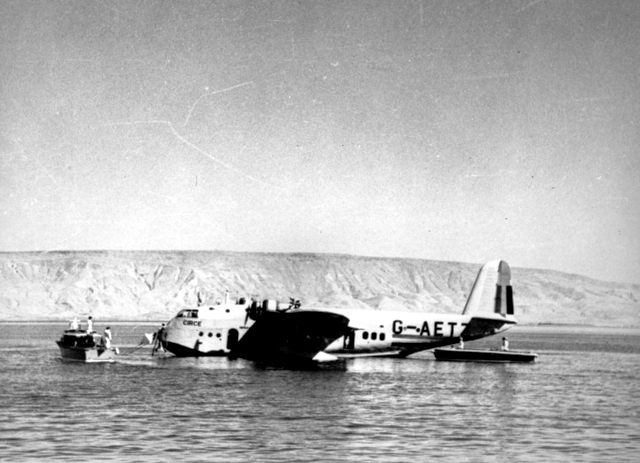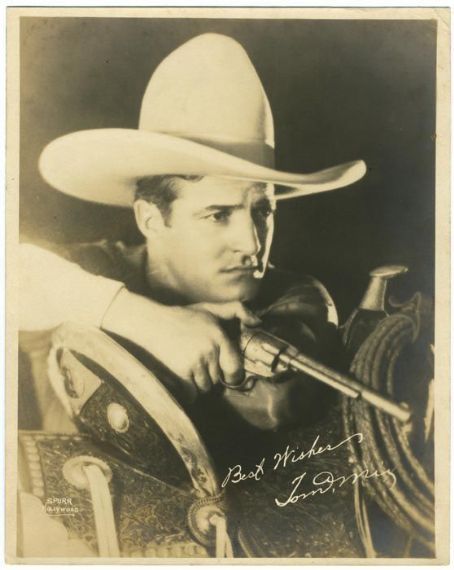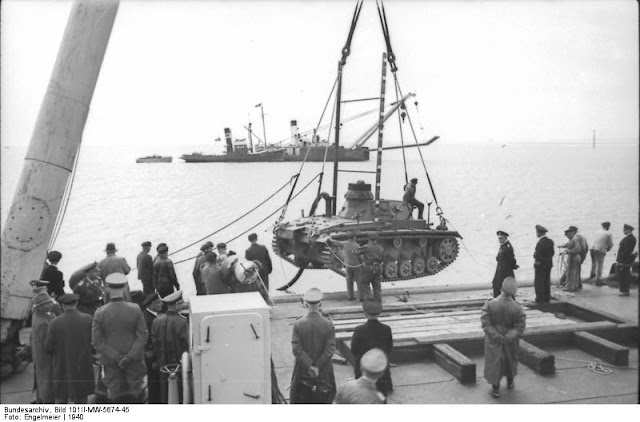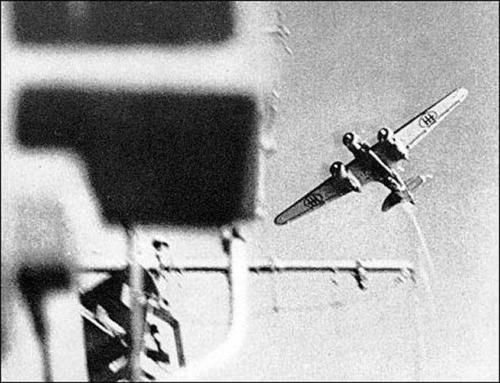Friday 13 February 1942
 |
| Imperial Japanese Army paratrooper landing to start the battle of Palembang, February 13, 1942. |
 |
| Japanese paratroopers landing in Sumatra, Dutch East Indies, 13 Feb 1942 (Japanese Navy photo). |
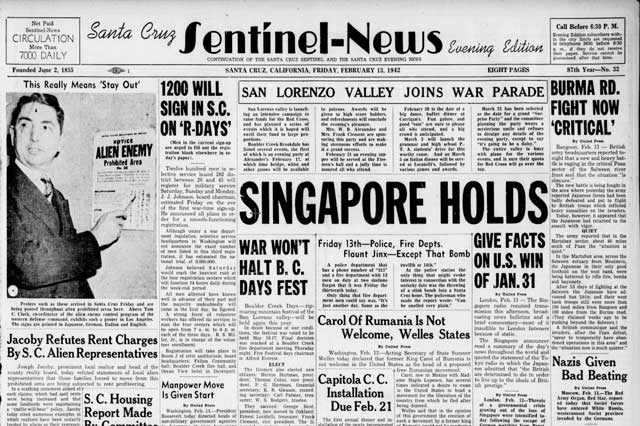 |
| The Santa Cruz (California) Sentinel-News, 13 February 1942, puts "Singapore Holds" as its main headline. |
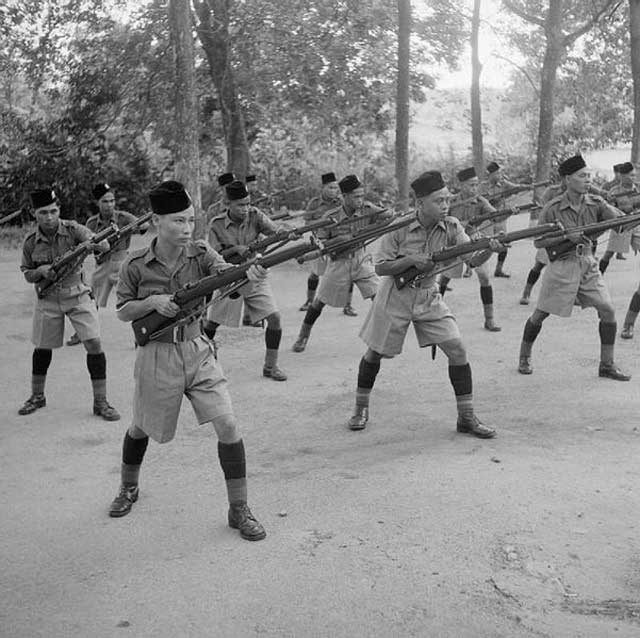 |
| The Malay Regiment at bayonet practice, October 1941. They are a key part of British defenses around the city of Singapore on 13 February 1942. © IWM (FE 414). |
 |
| HMS Tempest broaches the surface while being sunk by Italian gunboat Circe on 13 February 1942 (Difesa Online). |
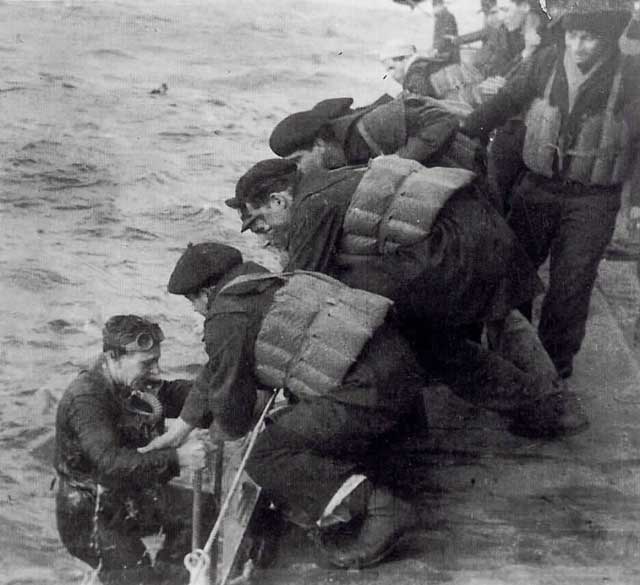 |
| Italian sailors on board the Circe rescue a British sailor from HMS Tempest on 13 February 1942. Note the Davis breathing apparatus that the man is wearing. |
 |
| SS President Taylor, shown after her loss on 13 February 1942. |
The USAAF Fifth Air Force sends 11 B-17 Flying Fortresses based on Java against Japanese shipping in the Makassar Strait. Ten bombers complete the mission, but the weather is cloudy and they claim a hit on only one ship.
 |
| SS President Taylor is visible in the background after her grounding on 13 February 1942. |
 |
| The 5424-ton British freighter SS Subadar, sunk by Japanese bombers off the Southern entrance to the Banka Strait on 13 February 1942. There are 65 survivors and 13 deaths. |
On the Crimea, both sides are building up their forces for attempts to evict the other side. Joseph Stalin and Stavka representative Lev Mekhlis wished to launch an attack today from the Red Army line at the Parpach Narrows, but the buildup of troops and supplies has been inadequate. The offensive is postponed to later in February.
 |
| "Flying Officer John G. Gorton (indicated by the arrow), later Prime Minister of Australia, among survivors from the torpedoed Merchant Ship SS Derrymore (4,799 tons) who are being taken aboard HMAS Ballarat. The survivors, numbering 215, included 189 British Airmen." Derrymore was a 4799-ton ammunition ship which was torpedoed by HIJMS I-55 on 13 February 1942 (some sources say 12 February). Australian War Memorial 126196. |
 |
| Minesweeper HMS Young Cliff "About to drop the gate part of the sweeping gears," Granton, Scotland, 13 February 1942 (© IWM (A 7392)). |
It is my duty to inform you that Operation Cerberus has been successfully completed.There are many ways to view the Channel Dash, and it is possible to say that the British "won" because the large ships no longer threatened Allied shipping in the Atlantic.
 |
| The Channel Dash is front-page news around the world. Here it is the main topic in The Springfield (Massachusetts) Union, 13 February 1942. |
 |
| Dummy tanks, mounted on trucks, being taken by the British to the front in North Africa, 13 February 1942 (© IWM (E 8361)). |
US/Canadian Relations: The United States and Canada agree to the construction of a U.S. military highway through Canada to Alaska. This is to be completed as soon as possible and will become known as the ALCAN Highway. The road idea has been kicking around within the United States government since the 1920s, but the Canadian government has refused to agree to any joint funding. The war situation, however, has produced a positive change in attitude in Ottawa. Both countries have proposed routes, but the route chosen is a third option, "Route C," aka the Prairie option, that has been developed by the United States Army Corps of Engineers. Construction is scheduled to begin on 8 March 1942 and be completed before winter.
 |
| Aboard minesweeper HMS Young Cliff, "Gunner Jim Crow keeping a sharp look-out for enemy aircraft." 13 February 1942. © IWM (A 7382). |
Norwegian/German Relations: Norwegian puppet leader Vidkun Quisling visits his patron, Adolf Hitler, in Berlin, along with Reich Commissioner in Norway Terboven.
Australian Military: The 39th Battalion completes the laying of about 40 km of telephone lines around Port Moresby because the high command believes that it will soon be attacked by the Japanese.
 |
| British Picture Sheet No. 29. Issued by Information Officer P.O. Box 384, Salisbury, 13 February 1942 (© IWM (Art.IWM PST 15679)). |
 |
| Port construction at Loch Ryan, Scotland, 13 February 1942 (© IWM (H 17198)). |
Grand Admiral Erich Raeder, whose "peripheral strategy" in the Mediterranean has produced positive results, meets with Adolf Hitler to discuss new proposals in the region. Raeder seeks to mount a major offensive in North Africa. This would entail eliminating the British position in Egypt and continuing on to the east. This, Raeder argues, would secure major oil supplies for the Reich and eventually lead to a junction of German and Japanese forces in India. As a preliminary to this massive operation, Hitler agrees to order Luftflotte 2 in the Mediterranean to subdue Malta. When informed of this proposed operation, Lieutenant General Erwin Rommel agrees that it is feasible.
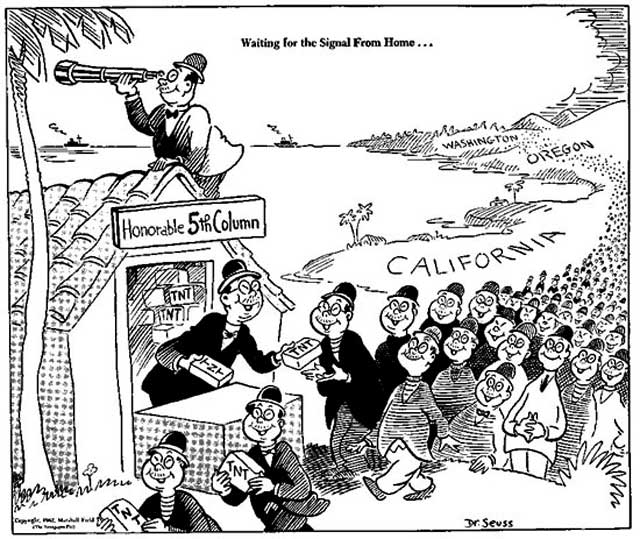 |
| Dr. Seuss cartoon, "Waiting for the signal from home," 13 February 1942 (Mandeville Special Collections Library, UC San Diego). |
We recommend the immediate evacuation of all persons of Japanese lineage and all others, aliens and citizens alike, whose presence shall be deemed dangerous or inimical to the defense of the United States from all strategic areas.
In defining said strategic areas we recommend that such areas include all military installations, war industries, water and power installations, oil fields, and refineries, transportation, and other essential facilities as well as adequate protective areas adjacent thereto.
We further recommend that such areas be enlarged as expeditiously possible until they shall encompass the entire strategic area of the states of California, Oregon and Washington, and Territory of Alaska.This is a key step in the internment of Japanese-Americans. The treatment of "all persons of Japanese lineage" is a hot topic throughout the United States government and in the public, too.
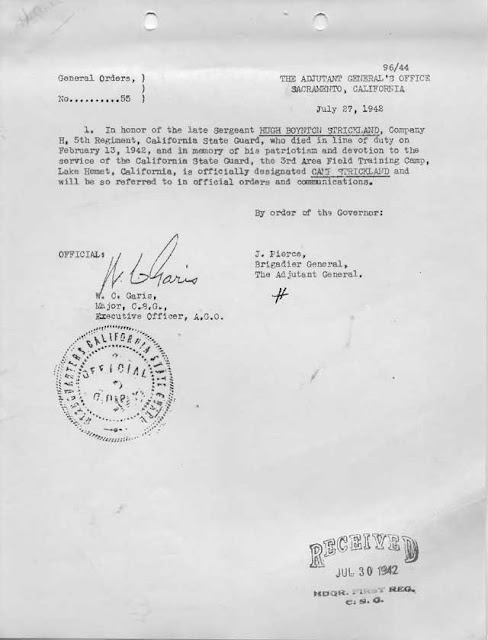 |
| Camp Strickland, a California State Guard Camp, receives its name on 27 July 1942 from California State Guard Sergeant Hugh Boyton Strickland, KIA on 13 February 1942. |
"Ride 'Em Cowboy" is released by Universal Pictures. It stars Bud Abbott and Lou Costello as peanut vendors who head West after getting into some trouble and get jobs as cowboys on a dude ranch. The film is notable for being filmed on two actual dude ranches, the B-Bar A and the Rancho Chihuahua. It also marks the film debut of Ella Fitzgerald. The film, directed by Arthur Lubin, is a smash hit at the box office. "Ride 'Em Cowboy" was actually shot in 1941, but Universal delayed its release because Abbott and Costello's other film "Keep 'Em Flying" was still doing well at the box office.
Future History: Peter Halsten Thorkelson is born in Washington, D.C. After growing up in Connecticut, Peter develops an interest in music and spends time playing the guitar and other stringed instruments in Greenwich Village. At some point, he changes his professional name to Peter Tork. While in New York, Tork meets Stephen Stills, a fellow fledgling musician. Stills auditions for a new television series about four young musicians, but fails to pass the audition. He recommends his friend Peter, and Tork gets the job. The new show is called "The Monkees" and is a smash hit, succeeding in both the television and pop music realms. Tork goes on to his own musical career in later years, though The Monkees reform several times over the years and even record new material in the 1980s. Peter Tork passes away on 21 February 2019 in Mansfield, Connecticut.
Carole Ann Jones is born in Manhattan, New York. She becomes a successful actress under the name Carol Lynley, appearing in numerous television series and making a big splash in "The Poseidon Adventure" (1972) as Nonnie Parry. Carol Lynley passes away on 3 September 2019 in Pacific Palisades, California.
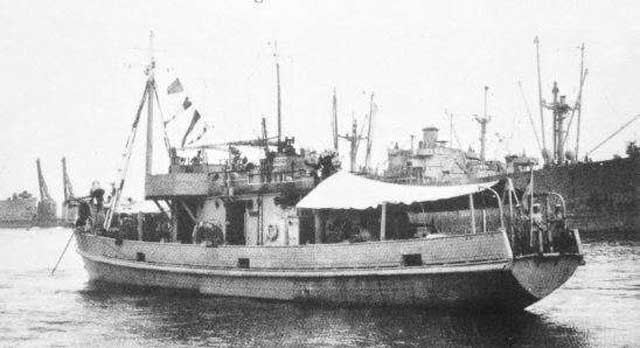 |
| British Royal Navy minesweeper MMS-180, sunk after a collision at the mouth of the River Tyne on 13 February 1942. Everyone survives. |
February 1942
February 1, 1942: The US Navy Strikes Back
February 2, 1942: Germans Recovering in Russia
February 3, 1942: Japanese Shell and Bomb Singapore
February 4, 1942: Battle of Makassar Strait
February 5, 1942: Empress of Asia Sunk
February 6, 1942: The Christmas Island Body
February 7, 1942: The Double-V Campaign
February 8, 1942: Japan Invades Singapore
February 9, 1942: French Liner Normandie Capsizes
February 10, 1942: US Car Production Ends
February 11, 1942: Tomforce Fails on Singapore
February 12, 1942: The Channel Dash
February 13, 1942: Japanese Paratroopers In Action
February 14, 1942: RAF Orders Terror Raids
February 15, 1942: Japan Takes Singapore
February 17, 1942: Indian Troops Defect to Japanese
February 18, 1942: Battle of Badung Strait
February 19, 1942: FDR Authorizes Internment Camps
February 20, 1942: O'Hare the Hero
February 21, 1942: Crisis in Burma
February 22, 1942: Bomber Harris Takes Over
February 23, 1942: Bombardment of Ellwood, California
February 24, 1942: US Raid on Wake Island
February 25, 1942: Battle of Los Angeles
February 26, 1942: Gneisenau Eliminated
February 27, 1942: Battle of Java Sea
February 28, 1942: Battle of Sunda Strait
2020


